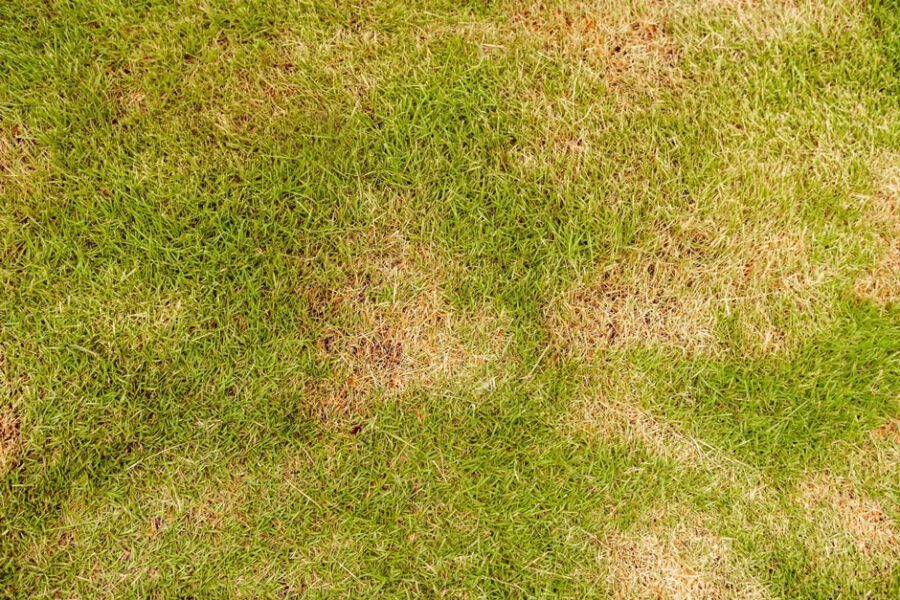Skip to the good bit
ToggleWarmer weather is finally here, and you are ready to enjoy sunny days in your backyard.
You step outside, waiting to see a verdant oasis, but instead, you find your lawn mined with brown, dead patches.
How did this happen?
Even the most careful homeowners get brown patches on their lawns occasionally.
These annoying and unesthetic marks can occur for many reasons.
In this article, we will explain the most common reasons behind brown grass patches. You’ll also learn how to fix them or if it’s necessary to call a lawn care and weed control service.
What Is Summer Lawn Stress?
Lawn stress happens when your lawn is exposed to harsh conditions for an extended period.
During the summer, those conditions could be extreme hot temperatures, poor watering, or intense sunlight.
The result? Stressed lawn often manifests as yellow or brown grass patches, sometimes leading to dead grass.
Why Is Your Grass Turning Brown and How To Fix It
Is your lawn exhibiting brownish patches during the summer?
Let’s find the reasons why this is occurring and how you can prevent or fix further lawn damage:
Inappropriate Watering
Poor watering practices are one of the main reasons for beige brown patches, specifically during the warm seasons.
Here is how over or underwatering your lawn can cause turf to turn brown:
- Underwatering: This can lead the grass to enter a dormant state, meaning it ceases activity to save energy.
- Overwatering: This can cause issues such as fungus developing on the roots, which weakens the grass and causes it to turn brown.
During midsummer, lawns typically require one to two inches of water weekly. While you can provide one substantial watering session each week, it’s more effective to divide this into two sessions.
Poor Mowing Practices
Mowing might seem like the simplest, most typical lawn care chore. However, this practice significantly impacts your grass health.
Let’s learn what happens when you mow your lawn too short or use dull blades:
- Mowing Too Short (Scalping): Cutting the grass too short (scalping) weakens and stresses it, making it harder for the grass to resist disease and remain healthy, which can result in brown patches.
- Dull Mower Blades: Dull blades tear the grass instead of providing a clean cut, potentially damaging the grass and causing it to turn brown.
Heat and Drought Stress
Even warm-grass types have their limit when it comes to intense summer temperatures.
Turf can experience stress during extended periods of extreme heat, particularly when accompanied by drought conditions.
Heat stress may appear as wilting, dormancy, or browning in grass blades. Browning serves as a protective measure to conserve water and reduce additional harm.
Lawn Disease or Weed
Many diseases and fungi can cause your lawn to turn brown. During this time of year, when watering is in full swing and humidity is often high, fungus is widespread.
Before you even notice, your small brown patches of grass may develop into large dead grass areas if the fungus isn’t eliminated.
Consider using a fungicide targeted at brown patches. Once the fungus is eliminated, your grass can begin to recover its vibrant green color. However, patience is key—it generally requires 28 to 30 days for regrowth.
And what about weed?
Weeds compete with your turf for water, nutrients, and sunlight, “stealing” the resources needed for a healthy lawn. A heavy weed infestation leads to noticeable browning.
Remove weeds as soon as you notice, or use a pre-herbicide during the beginning of spring.
Lawn Pests
You may not notice these tiny invaders as they strike, but the harm they inflict on your lovely green lawn is evident.
Certain lawn pests enjoy feasting on your grass’s delicate roots, nibbling the blades, and even dragging entire blades into their burrows for later consumption.
By committing to proper lawn care practices, you can keep a healthy yard where pests never set foot on.
Soil Compaction
All grass types need air, water, and other essential nutrients to reach their roots for proper growth.
The spaces between soil particles shrink when soil becomes compacted. That can happen due to freezing temperatures, heavy foot traffic, or clay-heavy soil.
This limits air and water flow, obstructing root system growth and nutrient absorption.
Stagnant water near the roots may also result in root rot, which can harm the grass and create brown spots or patches.
You can solve this issue by aerating your lawn or hiring professional lawn aeration services.
Pet Waste
There’s no better addition to your yard than your furry friends running around.
However, your pet could hold some responsibility for brown patches in your lawn…
If you notice round patches of brown spots on your lawn, it’s likely that a dog has left its mark! The acid in their urine can cause the grass to turn brown, giving the lawn a bit of a rough look.
Here are a few things you can try:
- Take your dog for a walk to a park or field instead of letting him roam on the lawn.
- Teach your pets to relieve themselves in a designated area of the yard.
Recover Your Verdant, Patches-Free Lawn
Tired of dead patches ruining your perfect garden?
Say goodbye to brown grass patches!
The first step is to identify the cause behind this problem. Then, you’ll know how to tackle it.
Are brown patches getting out of hand? Don’t hesitate to call lawn care experts for help. They’ll quickly and efficiently treat your lawn and help you achieve the garden of your dreams.







